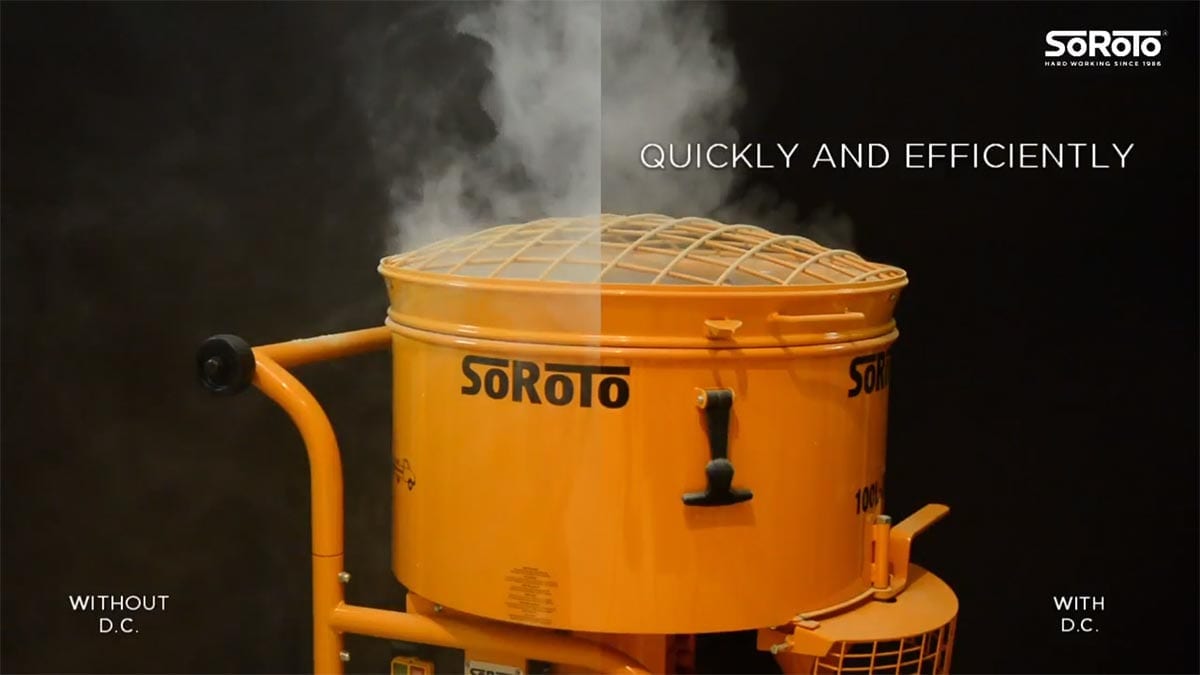SoRoTo dust eliminators or controllers are used as an attachment and are compatible with all SoRoTo forced action mixers. The eliminators are proven to reduce dust emittance by up to 80% and in turn lessen the chances of harmful materials being breathed in whilst mixing together dry materials. In this article we will look at how the dust controller can be used when mixing materials which give off potentially hazardous amounts of harmful dust, such as dry concrete, limestone or mortar. Without taking the necessary precautions when working with and mixing dry materials, serious health conditions can develop which we will explain more about below.
What are the affects of being exposed to dry material dust?
When bag dumping, cutting, sanding or grinding dry materials such as cement, limestone, mortar and even sand, dust is released dominates the space around. If eyes or skin are exposed or the dust is inhaled, it can lead to serious long term health issues both externally and internally.
Watch this video showing and explaining how Silica can damage a persons lungs:
Externally, workers can become allergic to a part of cement called hexavalent chromium which a small percent of workers develop after minutes or even years of working with cement. But once you have the allergy, it typically lasts a lifetime and will almost prevent all future work with wet concrete or powder cement. The symptoms of this can range from mild rashes to severe skin ulcers as the moisture from sweat or wet clothing reacts with the cement dust to form a caustic solution. If you aren’t familiar with what a caustic solution is, it is an alkaline solution used to dissolve grease, oils, fats and protein-based deposits and is actually highly corrosive to skin tissue. As well as the previous points mentioned, if your eyes are exposed to airborne dry material dust, immediate or delayed eye irritation can take place dependent on the level of exposure. Exposure can lead to a variety of issues from just soreness and redness to chemical burns and in some cases even leads to blindness.
Internally, workers mixing dry materials that emit large amounts of dust can develop mild issues or serious respiratory issues varying from irritated noses and wheezing to silicosis or lung disease. The severity can depend on the amount of time spent exposed to harmful dust or the type of material used as certain materials contain higher levels of harmful compounds compared to others. Most materials that cause respiratory issues contain high levels of crystalline-silica which can be found in:
Asphalt, block, brick, ceramic tile, concrete, granite, grout, joint compound, mortar, pavers, roof, tiles, sand, slate, some siding, terrazzo and more.
Silica is a natural compound found in many materials which are commonplace on a construction site, including soil, sand, concrete, masonry, rock, granite, and landscaping materials. It is harmful once it becomes a dust which can occur when mixing or cutting as it then contains crystalline silica particles which is very hazardous substance. A study from the Royal College of Surgeons of England found that harmful dusts emitted from dry materials can in some cases lead to the development of silicosis or scarring of the lungs, which results in a loss of lung function and severe shortness of breath. They also discovered that very large amounts of exposure to high concentrations can ultimately lead to death.
How to prevent harmful dust from affecting your short and long-term health
Although it may seem like a very bleak outlook and dry materials should not be used, along with wearing the correct PPE there is a simple solution to minimising the amount harmful dust being emitted from dry materials which can be mixed together in a forced action mixer.
Watch our video to see how when in use, our Dust Controllers can reduce the amount of potentially harmful dust being spread into the surrounding area:
The Dust Controller attachment can be used with almost all hoovers which can be attached to the controller to suck as much dust out of the air as possible before it has chance to leave the mixer. When tested, our dust eliminator has proven to reduce dust emittance by up to 80% which is fantastic. The controller minimises the amount of dust in the air without compromising your access to and view of the materials being mixed inside the forced action mixer.
If you have any questions about our dust controllers, forced action mixers or any of our other products then please do not hesitate to contact a member of our knowledgeable and helpful team.
Information sourced from:
http://elcosh.org , http://www.atlanticbulk.com, http://www.hse.gov.uk, https://www.silica-safe.org & https://www.worksafebc.com


